Maximize Green Space with an Outdoor Vertical Garden Wall and transform your outdoor space into a vibrant and lush garden, even within limited spaces. Vertical gardening offers a practical and aesthetically pleasing solution for those who want to make the most of their outdoor areas. By growing plants vertically, you can maximize the use of your available space and create a lush and vibrant garden without taking up valuable ground space. Whether you have a small patio, balcony, or limited yard, vertical gardening allows you to enjoy the beauty and benefits of a garden in any outdoor space.
Key Takeaways:
- Vertical gardening is an effective way to maximize green space in outdoor areas with limited space.
- By growing plants upwards, you can create a vibrant and lush garden without taking up valuable ground space.
- Vertical gardening is suitable for various outdoor spaces, including small patios, balconies, and even limited yard areas.
- Choosing the right plants for vertical gardens, such as flowers, succulents, vines, vegetables, and fruits, is essential for successful vertical gardening.
- Container vertical gardens and ground-based vertical gardens are popular options for implementing vertical gardening techniques.
- Vertical gardening can also be done without soil, using hydroponic gardening or aeroponic setups.
- Proper location, plant placement, sunlight, wind protection, and regular maintenance are key factors for successful vertical gardening.
- Vertical gardening can be a cost-effective and sustainable way to create a beautiful and functional outdoor space.
- Explore vertical gardening success stories and find inspiration for your own vertical garden designs.
- In conclusion, vertical gardening offers a versatile and accessible solution for maximizing green space and transforming outdoor areas into vibrant and lush gardens.
Benefits of Vertical Gardening
Vertical gardening offers numerous benefits, making it a popular choice for those who want to maximize their garden space in small areas. Whether you have a balcony, patio, or limited yard space, vertical gardening allows you to create a lush and vibrant garden that adds aesthetic appeal to any outdoor setting. Here are some of the key benefits of vertical gardening:1. Aesthetic Appeal: Vertical gardens add a unique and visually stunning element to your outdoor space. By utilizing vertical space, you can create a stunning green wall or display that becomes a focal point in your garden. Whether you choose to grow flowers, succulents, or vining plants, the vertical arrangement creates a sense of depth and beauty.2. Less Labor: Vertical gardens require less maintenance and labor compared to traditional gardens. Since the plants are grown vertically, there is less bending and squatting required for planting, weeding, and harvesting. This makes vertical gardening a suitable option for individuals with physical limitations or those who prefer a low-maintenance garden.3. Efficient Irrigation: Vertical gardening allows for more efficient irrigation practices. Watering systems can be set up to deliver water directly to the roots of the plants, reducing water waste and optimizing water usage. Additionally, the vertical arrangement allows for better air circulation and water drainage, minimizing the risk of overwatering and waterlogged soil.4. Less Water: Vertical gardens typically require less water compared to traditional gardens. Due to the vertical arrangement, water from higher-level plants can trickle down to lower-level plants, maximizing water usage and reducing the need for excessive watering. This water-saving feature makes vertical gardening an eco-friendly choice for those who want to conserve water.In summary, vertical gardening offers numerous benefits, including aesthetic appeal, less labor, efficient irrigation, and reduced water consumption. With the right plant selection and proper care, vertical gardens can transform any outdoor space into a vibrant and thriving oasis.Table: Vertical Gardening Benefits
| Benefits |
|---|
| Aesthetic Appeal |
| Less Labor |
| Efficient Irrigation |
| Less Water |
Choosing the Right Plants for Vertical Gardens
When creating a vertical garden, it’s important to choose plants that will thrive together and complement each other in terms of height and growth patterns. By selecting the right plants, you can create a vibrant and lush garden that maximizes the limited space available in vertical gardening.
Here are some plant options that work well in vertical gardens:
- Flowers: Choose flowers with non-woody stems, such as gerber daisies, freesia, and carnations. These plants have a tendency to spill over and dangle, adding visual interest to your vertical garden.
- Succulents: Succulents are compact and have shallow root structures, making them ideal for vertical gardens. They require less soil to survive and can add a stunning aesthetic to your garden.
- Vines: Vines are natural climbers and can add a lot of greenery to your vertical garden. Morning glories and climbing hydrangea are excellent choices that can climb over various structures like brick walls, trellises, wire fences, and wooden fences.
- Vegetables and fruits: Vertical gardening is not just limited to flowers and decorative plants. You can also grow vegetables and fruits vertically to maximize your harvest. Cucumbers, winter squash, pole beans, snap peas, and gourds like loofah are great options for vertical vegetable gardening. Perennial fruits such as grapes, blackberries, raspberries, and melons can also thrive in a vertical garden.
It’s essential to consider the needs of each plant, such as sunlight, water requirements, and any specific care instructions. By selecting plants that have similar needs, you can ensure they thrive together in your vertical garden.
Good Neighbors in a Vertical Garden
When choosing plants for your vertical garden, it’s important to consider their compatibility as “good neighbors.” Some plants may compete for resources or grow in a way that shades out others. Here are some tips for selecting compatible plants:
- Place taller plants or structures at the north or west side of your garden to prevent them from shading out shorter plants. This ensures that all plants receive adequate sunlight.
- Consider the growth habits of each plant. Plants with invasive root systems or those that spread rapidly may not be suitable for vertical gardens with limited space.
- Create a mix of plants with varying heights and growth patterns to add visual interest and prevent overcrowding.
By carefully choosing the right plants and ensuring they are good neighbors, you can create a thriving and beautiful vertical garden that maximizes your outdoor space.
Table: Vertical Garden Plant Options
| Plant Type | Examples |
|---|---|
| Flowers | Gerber daisies, freesia, carnations |
| Succulents | Aloe vera, echeveria, sedum |
| Vines | Morning glories, climbing hydrangea, clematis |
| Vegetables | Cucumbers, winter squash, pole beans |
| Fruits | Grapes, blackberries, raspberries |
When selecting plants for your vertical garden, take into consideration their specific care needs and ensure they are compatible with each other. With the right plant choices, your vertical garden will thrive and bring beauty to your outdoor space.
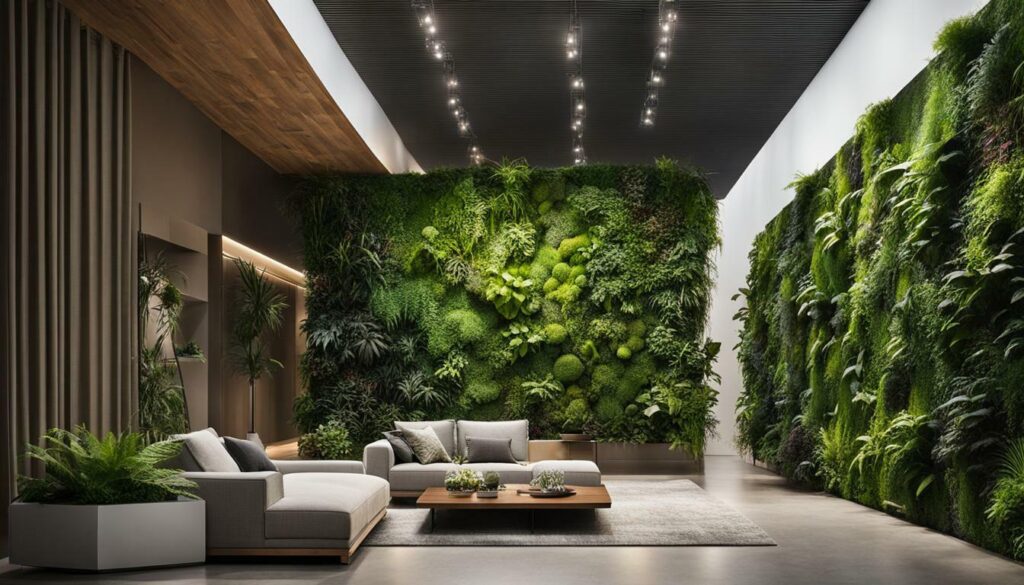
Container Vertical Gardens
Container vertical gardens provide a convenient and versatile solution for growing plants vertically, with options ranging from ready-made containers to DIY projects using various containers as the foundation. Whether you have limited outdoor space or simply want to maximize the greenery in your garden, container vertical gardens offer a practical and aesthetically pleasing solution.
There are several creative DIY projects that can help you get started on your container vertical gardens. Wall planters, for example, are a simple and effective option. All you need is a bucket or any container with proper drainage that can be hung on a wall. Fill it with soil, plant your desired herbs or greens, and let them thrive in the vertical space. Wall planters not only add vibrancy to your outdoor areas, but they also make weeding easier and don’t take up valuable outdoor space.
Gutters can also be repurposed into the perfect vertical garden. Attach gutters to the sides of your fence, shed, or house, ensuring there is enough space between them for sunlight to reach the plants. Drill drainage holes in the gutters to prevent overwatering and allow water to drip down onto lower levels.
If you’re looking for a budget-friendly and eco-friendly option, consider utilizing plastic bottles as containers for your vertical garden. Cut a hole in the side of any soda or water bottle and attach it to a vertical structure. Fill it with soil and plant small plants like herbs and salad greens. This DIY project not only reduces plastic waste but also adds a unique and sustainable touch to your garden.
| Container Type | Advantages |
|---|---|
| Wall Planters | Space-saving, easy to maintain, suitable for herbs and greens |
| Gutters | Cost-effective, customizable length, ideal for sunlight exposure and drainage |
| Bottle Garden | Eco-friendly, great for small plants, reduces plastic waste |
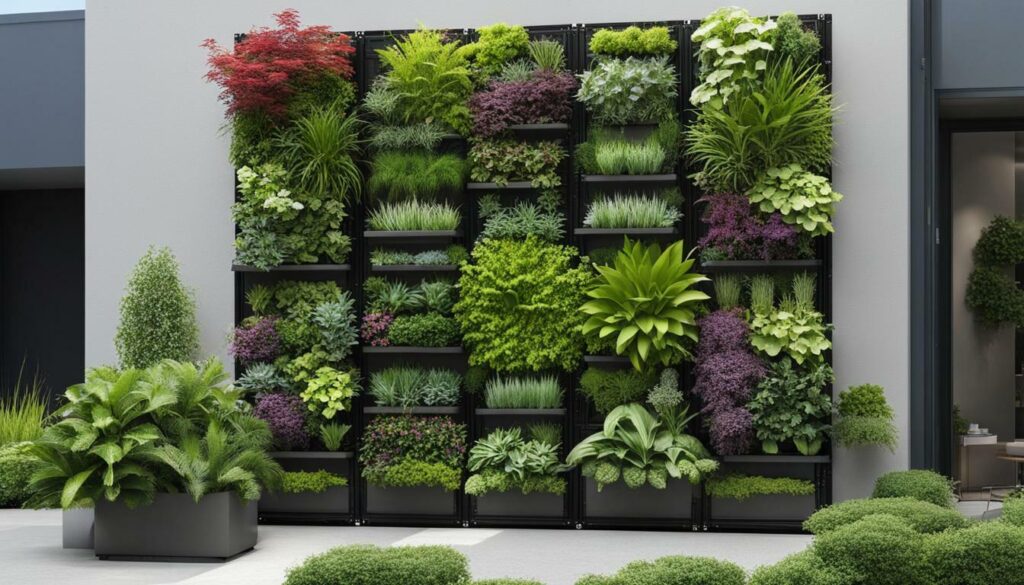
“Container vertical gardens offer a practical and aesthetically pleasing solution.”
Ground-Based Vertical Gardens
Ground-based vertical gardens utilize trellises and the natural climbing abilities of vining plants to create stunning vertical displays in outdoor spaces. By harnessing the verticality of plants, these gardens maximize the use of space, making them ideal for small patios, balconies, or any limited outdoor areas. With the right support structures and plant choices, ground-based vertical gardens can transform any space into a lush and vibrant oasis.
One popular method for ground-based vertical gardening is the use of trellises. Trellises provide a framework for vining plants to climb and grow, adding height and visual interest to a garden. Metal poles, fences, bamboo, and even old scraps of lumber can be repurposed into trellises, offering a cost-effective and customizable solution. It is important to ensure that the chosen trellis can support the weight of the plants, especially if growing heavier varieties like pumpkins or watermelons.
When selecting vining plants for a ground-based vertical garden, consider their growth habits and optimal support. Plants like morning glories, climbing hydrangea, and ivy are excellent choices as they can climb and cling to various structures such as brick walls, wire fences, and wooden trellises. These plants not only add greenery and texture but also help create privacy by covering unsightly walls or fences.
To illustrate the benefits of ground-based vertical gardens, we can look at a comparison table of trellis materials, vining plant options, and optimal support:
| Trellis Material | Vining Plant Options | Optimal Support |
|---|---|---|
| Metal poles | Morning glories, climbing roses | Securely anchored poles |
| Bamboo | Ivy, clematis | Sturdy framework |
| Wire fences | Hydrangea, wisteria | Proper attachment to fence |
| Wooden trellises | Green beans, cucumbers | Securely fastened to trellis |
With the right plants and support structures, ground-based vertical gardens can transform even the smallest outdoor spaces into vibrant and green sanctuaries. Whether you choose to utilize trellises, fences, or other creative options, the possibilities are endless when it comes to creating a stunning vertical garden.
Vertical Gardening for Small Patios and Balconies
Vertical gardening offers exciting possibilities for small spaces like patios and balconies, with options ranging from ready-made towers to budget-friendly solutions and even hanging baskets. These innovative approaches allow individuals with limited outdoor areas to create beautiful and thriving gardens.
Ready-made towers are a convenient option for vertical gardening on small patios and balconies. These towers are designed with multiple planting pockets that can accommodate a variety of plants, from flowers to herbs and vegetables. They provide a compact yet efficient way to maximize vertical space and create a lush garden in a limited area. With ready-made towers, gardening becomes accessible to everyone, regardless of their experience or expertise.
For those on a budget, there are plenty of cost-effective alternatives for vertical gardening. DIY projects using simple materials like recycled pallets or wooden crates can be transformed into vertical planters. These budget-friendly options not only add a touch of creativity to the space but also allow for customization to suit individual preferences. Hanging baskets are another excellent choice for small spaces. They can be easily attached to walls or railings, creating a cascade of greenery and flowers.
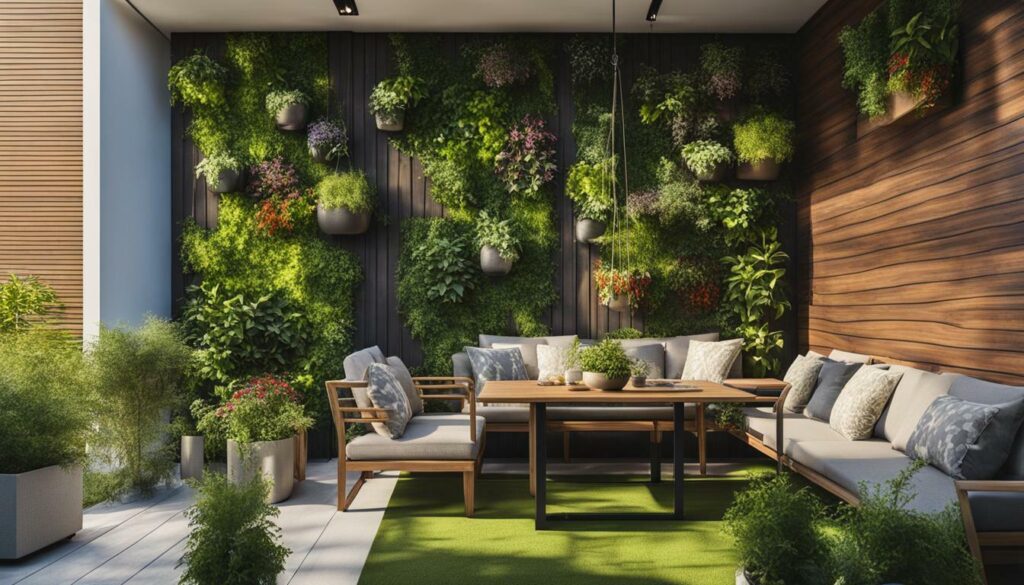
When implementing vertical gardening on patios and balconies, it is important to consider the specific needs of the plants. Some plants thrive in shade, while others require direct sunlight. By carefully selecting the right plants for the available light conditions, you can ensure their optimal growth and health. Additionally, proper watering and drainage are crucial to prevent overwatering or waterlogged roots. Placing a layer of gravel at the bottom of the containers can help improve drainage.
Example of a Vertical Garden Plan for a Small Balcony
| Level | Plants |
|---|---|
| Top | Trailing vines (e.g., ivy, sweet potato vine) |
| Middle | Flowering plants (e.g., petunias, geraniums) |
| Bottom | Herbs and small vegetables (e.g., basil, cherry tomatoes) |
Vertical gardening offers a creative solution for maximizing space and bringing nature into small outdoor areas. Whether using ready-made towers, budget-friendly options, or hanging baskets, anyone can transform their small patio or balcony into a vibrant garden. With careful plant selection and proper care, even the tiniest spaces can become an oasis of greenery and beauty.
Vertical Gardening Without Soil
Vertical gardening without soil opens up possibilities for innovative techniques such as hydroponic gardening and aeroponic setups, offering unique options for growing plants vertically. These methods eliminate the need for traditional soil, allowing plants to thrive in alternative growing mediums. Hydroponic gardening involves using a liquid planting medium, like water or a nutrient-rich solution, to provide plants with essential elements for growth. Aeroponic setups, on the other hand, utilize foam or other materials to support the plants’ roots and deliver moisture through mist or nutrient-dense liquid.
One benefit of vertical gardening without soil is the ability to grow a wide variety of plants, including flowers, herbs, and vegetables, in smaller spaces. These techniques are particularly well-suited for urban gardening or balconies where space may be limited. With hydroponic and aeroponic setups, plants can be grown vertically in towers or prefabricated systems, making efficient use of available space.
To ensure successful vertical gardening without soil, careful consideration must be given to plant choices. Certain plants are better suited for hydroponic or aeroponic systems, as their root structures and nutrient requirements differ from those that thrive in traditional soil. Examples of plants suitable for these methods include amaryllis, iris, daffodils, and various herbs. Understanding the specific needs of each plant is essential for creating a thriving vertical garden without soil.
With the right techniques and plant choices, vertical gardening without soil offers a unique and efficient way to maximize green space and enjoy the benefits of gardening in limited areas.
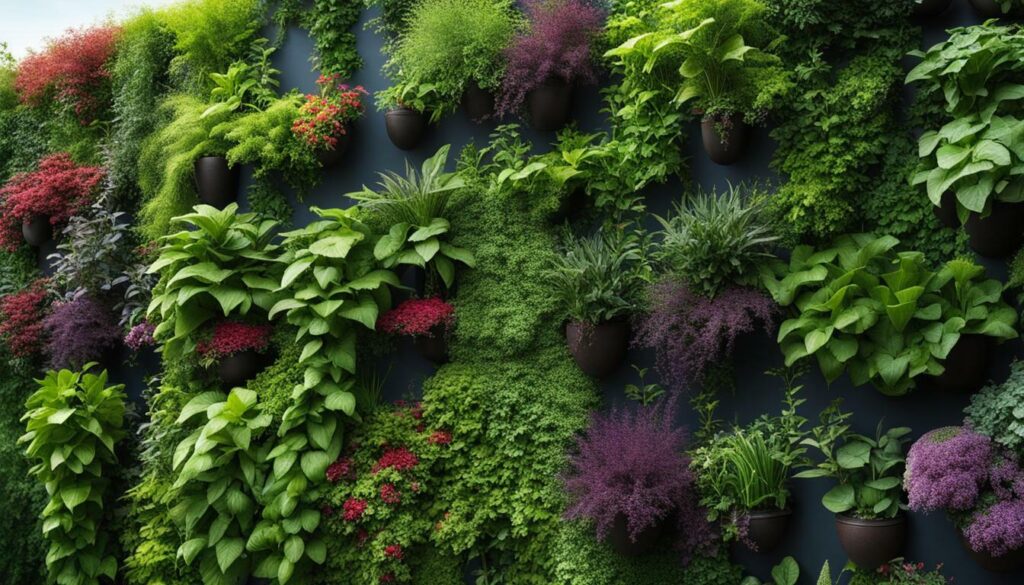
Comparison Table: Vertical Gardening Techniques
| Technique | Description | Advantages |
|---|---|---|
| Hydroponic Gardening | Plants are grown in a liquid planting medium without soil, receiving essential nutrients through the water. | Conserves water, eliminates weeds, requires less space, faster growth, precise control over nutrient intake. |
| Aeroponic Setups | Plants are grown with their roots suspended in air and moistened with a nutrient-rich mist or liquid. | Efficient water and nutrient usage, fast growth, reduced pest and disease risk, precise control over growing conditions. |
Tips for Successful Vertical Gardening
To achieve success in vertical gardening, it’s essential to consider factors such as location, plant placement, sunlight exposure, wind protection, and regular care and maintenance. By optimizing these key aspects, you can create a thriving vertical garden that maximizes your outdoor space and yields beautiful and healthy plants.
Location and Plant Placement
Choose a location for your vertical garden that receives adequate sunlight for the specific plants you are cultivating. Most plants require at least 6 hours of direct sunlight each day. Additionally, consider the orientation of your garden, placing taller plants or structures on the north or west side to prevent shading lower-level plants. Proper plant placement ensures that each plant receives optimal sunlight and allows for healthy growth.
Protecting Against Wind
If your vertical garden is exposed to strong winds, provide protection by placing it against a fence or wall. You can also install wind barriers, such as trellises or mesh screens, to shield your plants from excessive wind. Protecting your garden from strong gusts helps prevent damage to the plants and ensures their stability.
Proper Care and Maintenance
Regular watering, fertilization, and pruning are essential for the well-being of your vertical garden. Ensure that your plants receive sufficient water based on their specific needs, taking care not to overwater or underwater them. Fertilize your plants according to their requirements, providing them with the necessary nutrients to thrive. Pruning helps maintain the shape of your plants, promotes healthy growth, and prevents overcrowding.
| Tips for Successful Vertical Gardening |
|---|
| Choose a location with adequate sunlight |
| Place taller plants on the north or west side |
| Protect against strong winds with barriers |
| Water, fertilize, and prune regularly |
By following these tips, you can create a successful vertical garden that thrives in limited outdoor spaces. With proper location, plant placement, wind protection, and regular care, your vertical garden will flourish, providing you with a vibrant and lush outdoor space.
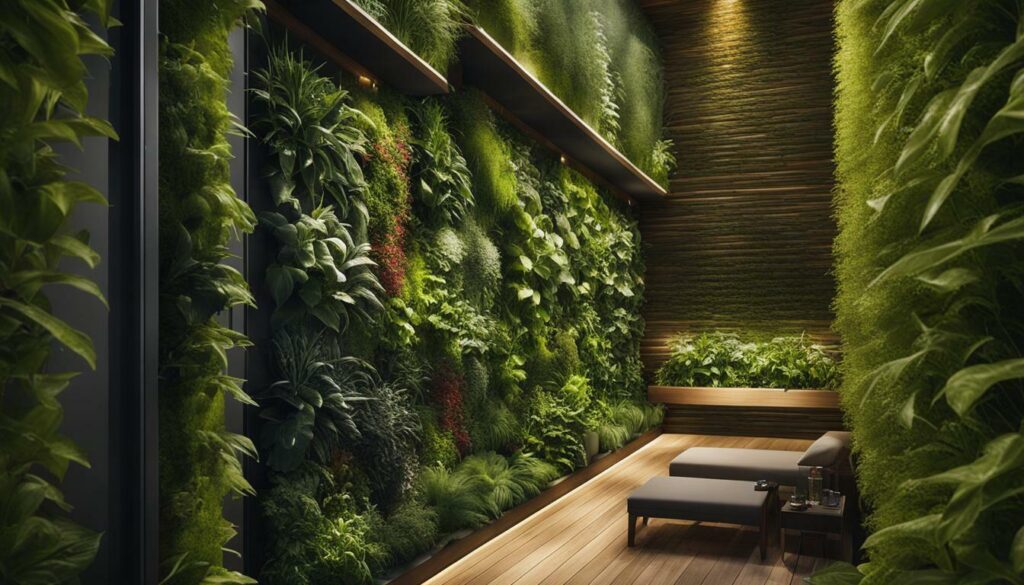
Maintenance and Care of Vertical Gardens
Proper maintenance and care are crucial for the success of vertical gardens, involving regular watering, appropriate fertilization, pruning, and effective pest control strategies. Vertical gardens require consistent attention to ensure the health and vitality of the plants. Here are some essential tips for maintaining and caring for your vertical garden:
Watering
Watering is a critical aspect of vertical garden maintenance. Due to the unique structure of vertical gardens, water distribution may be different compared to traditional gardens. It is essential to monitor the moisture levels regularly and adjust the watering schedule accordingly. Automated irrigation systems can be beneficial in ensuring that plants receive the correct amount of water. Additionally, consider using a water-retaining medium or incorporating a drip irrigation system to optimize water usage.
Fertilization
Proper fertilization is necessary to provide essential nutrients to the plants in a vertical garden. Choose a high-quality fertilizer specifically formulated for vertical gardening and follow the recommended application instructions. Pay attention to signs of nutrient deficiencies, such as yellowing leaves or stunted growth, and adjust the fertilization regimen accordingly. Regularly check the soil’s pH levels to ensure it remains within the optimal range for your plants.
Pruning
Regular pruning is essential for maintaining the shape and size of plants in a vertical garden. Remove any dead, damaged, or overgrown foliage to promote healthy growth and prevent the spread of diseases. Pruning also helps improve air circulation within the vertical garden, reducing the risk of fungal infections and pest infestations. Use clean and sharp pruning tools to make precise cuts, avoiding any unnecessary stress to the plants.
Pest Control
Vigilant pest control is crucial in vertical gardens to protect the plants from infestations that can quickly spread throughout the entire structure. Regularly inspect the plants for signs of pests, such as chewed leaves or discoloration. Identify the specific pests and choose appropriate organic or chemical pest control methods to prevent further damage. Consider implementing companion planting strategies to naturally deter pests and attract beneficial insects.
By following these maintenance and care practices, you can ensure the health and longevity of your vertical garden. Remember to monitor the plants regularly, adapt your care routine to their specific needs, and seek professional advice if you encounter any challenges. With proper attention and care, your vertical garden will thrive and continue to enhance your outdoor space.
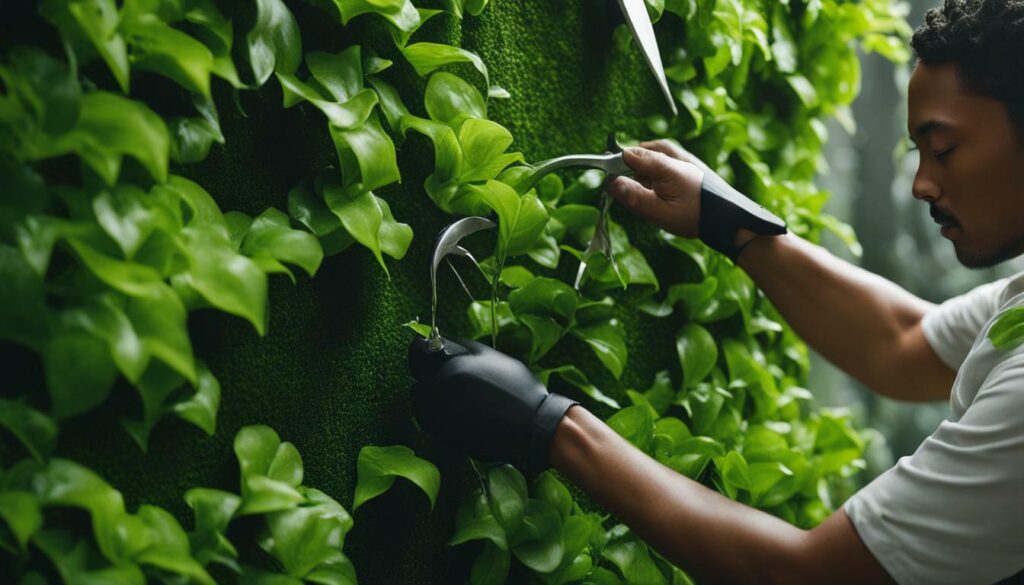
| Essential Maintenance Tips for Vertical Gardens: |
|---|
| Regular watering to ensure adequate moisture levels |
| Appropriate fertilization with specialized vertical garden fertilizer |
| Pruning to maintain plant shape and promote healthy growth |
| Vigilant pest control to prevent infestations and disease |
Vertical Gardening Success Stories and Inspiration
Discover inspiring success stories and real-life examples of stunning vertical gardens, showcasing the creativity and beauty that can be achieved with this innovative gardening technique.
One of the best ways to maximize limited outdoor space is by embracing vertical gardening. This method has gained popularity across the nation, and many gardeners have successfully transformed their outdoor areas with vibrant and lush vertical gardens. Whether you have a small backyard, balcony, or even just a wall to work with, vertical gardening offers endless possibilities.
One example of a successful vertical garden project is the use of wall planters. These simple yet effective structures, such as a bucket on a nail or a custom-designed planter, can brighten up any outdoor space while saving valuable floor area. They are perfect for growing herbs or greens that don’t require much soil or space to thrive, allowing you to enjoy fresh produce right at your fingertips.
| Vertical Garden Idea | Benefits |
|---|---|
| Gutters | Repurposed gutters can be attached to fences or walls, maximizing vertical growing space and allowing for efficient drainage and water distribution. |
| Bottle Garden | A creative and eco-friendly DIY project that repurposes plastic bottles into vertical planters, perfect for growing small plants like herbs and salad greens. |
| Plant Vines on Your Property | Vines are natural climbers and can be trained to grow on various structures such as trellises, fences, and walls, adding abundant greenery and aesthetic appeal to your landscape. |
| Trellises | Transform virtually anything into a trellis, providing vertical support for climbing plants like watermelons and pumpkins, maximizing space and preventing them from taking over your entire garden. |
| PVC Tower | A clever DIY garden project using a thick PVC pipe with strategically placed planting holes, ideal for growing strawberries or creating a high-functioning salad farm. |
Expert Tip:
“Vertical gardening is not only a great solution for limited outdoor spaces but also a creative way to add visual interest and functionality to your garden. Whether you’re repurposing everyday objects or building custom structures, vertical gardens offer endless opportunities for creativity and greenery.” – Kelly Smith Trimble, author of “The Creative Vegetable Gardener”
Vertical gardening is not limited to traditional soil-based methods. Hydroponic and aeroponic setups are gaining popularity as innovative ways to grow plants vertically without soil. These systems use water or a nutrient-rich solution as a planting medium, providing plants with the essential elements they need to thrive.
For those looking to maximize greenery in small spaces like balconies or patios, ready-made towers or hanging baskets offer convenient options. They are easy to install, budget-friendly, and can be customized with a variety of plants to suit your personal style and preferences.
Whether you prefer a traditional soil-based vertical garden or want to explore hydroponic and aeroponic systems, vertical gardening offers a versatile and sustainable way to transform your outdoor spaces. With the right plants, creative structures, and proper care, you can create a visually stunning and functional garden that will inspire and delight.
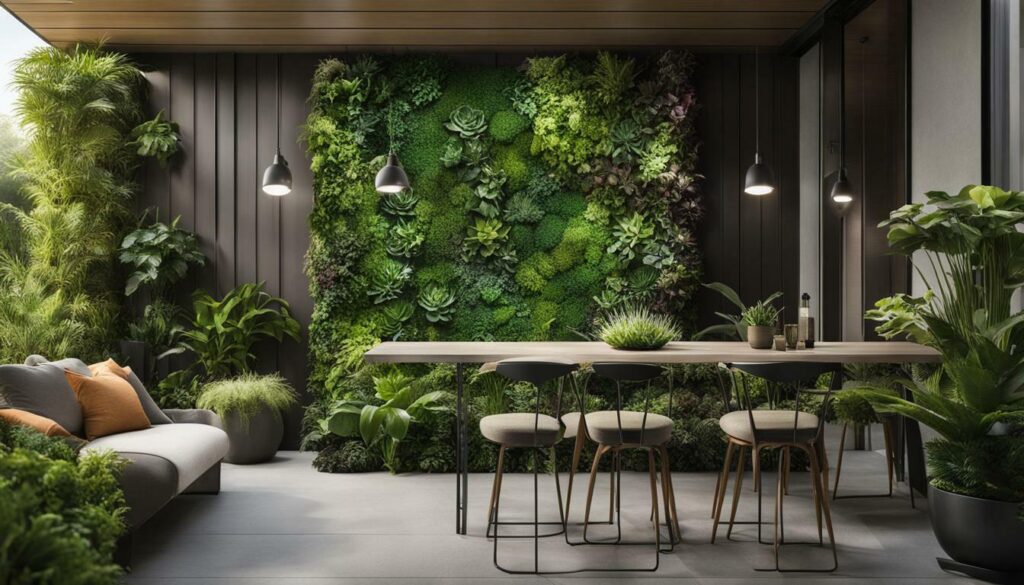
Take inspiration from these vertical gardening success stories and start exploring the possibilities for your own outdoor space. By embracing vertical gardening techniques, you can maximize green space, add aesthetic appeal, and create a thriving oasis in even the most limited areas.
Conclusion
Vertical gardening offers a multitude of benefits and possibilities, making it a versatile and accessible solution for transforming outdoor spaces and maximizing greenery in any landscape. By implementing vertical gardening techniques, individuals with limited outdoor space can create vibrant and lush gardens that add beauty and functionality to their surroundings.
One of the key benefits of vertical gardening is its ability to maximize green space in small areas. Whether it’s a balcony, patio, or a tight backyard, vertical gardens utilize the vertical dimension, allowing plants to grow upwards and saving valuable floor space. This enables individuals to enjoy the beauty of a garden even in limited spaces.
Vertical gardening also offers a range of advantages, including aesthetic appeal and reduced labor. The vertical arrangement of plants creates visual interest and adds a unique dimension to the outdoor space. Additionally, vertical gardens require less bending and squatting, making them easier to maintain and reducing strain on the back and legs.
Another significant advantage of vertical gardening is its efficiency in irrigation. Overflow from higher-level plants trickles down to the lower levels, reducing water usage and ensuring that plants receive adequate hydration. This makes vertical gardens more water-efficient compared to traditional gardens, making them an eco-friendly option.
When it comes to choosing plants for vertical gardens, there are various options available. Flowers, succulents, vines, vegetables, and fruits can all thrive in vertical spaces, creating a diverse and visually appealing garden. By carefully selecting the right plants for compatibility and providing proper care, individuals can achieve a flourishing vertical garden.
Whether utilizing container vertical gardens, ground-based vertical gardens with trellises, or vertical gardening techniques without soil such as hydroponic or aeroponic setups, there are options to suit every preference and space.
Successfully maintaining vertical gardens requires attention to location, proper plant placement, sunlight exposure, wind protection, and regular care. By following these tips and providing adequate watering, fertilization, pruning, and pest control, vertical gardens can thrive and bring joy to their owners.
Vertical gardening success stories and real-life examples can inspire individuals to explore and experiment with different vertical garden designs. These stories showcase the possibilities and transformation that can be achieved through vertical gardening, encouraging individuals to create their unique green oasis.
In conclusion, vertical gardening offers a versatile and accessible solution for maximizing green space in outdoor areas with limited space. With its numerous benefits, including space-saving, aesthetic appeal, reduced labor, efficient irrigation, and the ability to grow a variety of plants, vertical gardening has the potential to transform any outdoor space into a vibrant and lush garden.
How Can I Use an Outdoor Vertical Garden Wall to Grow Lettuce?
Utilizing an efficient vertical lettuce garden is a great way to grow lettuce on an outdoor vertical garden wall. By maximizing space and using a vertical setup, you can grow more lettuce in a smaller area. This method also helps with air circulation and drainage, leading to healthier and more abundant lettuce growth.
FAQ
Q: What is vertical gardening?
A: Vertical gardening is a technique that trains plants to grow upward, either from the ground, in containers, or as part of a multi-tier system. It is a practical and aesthetic solution for maximizing garden space in small or urban areas.
Q: What types of plants work in a vertical garden?
A: Plants that work well in vertical gardens include flowers with non-woody stems, succulents, vines like morning glory and climbing roses, and vegetables such as cucumbers, winter squash, pole beans, and snap peas. Perennial fruits like grapes and blackberries also thrive in vertical gardens.
Q: What are the benefits of vertical gardening?
A: Vertical gardening saves space, adds aesthetic appeal, requires less labor, and has more efficient irrigation and fertilization. It also usually requires less water than traditional gardens.
Q: How do I create a container vertical garden?
A: You can use ready-made containers or build your own vertical container garden using a large flower pot as the base and chicken wire as the structure. Place taller plants or vining plants towards the bottom and smaller plants towards the top to prevent shading.
Q: How do I create a ground-based vertical garden?
A: Insert a trellis into the ground and surround it with vining plants. Use the slits or holes in the trellis to train the plants to climb upward. Alternatively, use existing fences and plant vining plants a few inches away, allowing them to grow and cover the fence.
Q: How can I do vertical gardening on a small patio or balcony?
A: Ready-made towers or connecting pots with a garden arch are options for vertical gardening in small spaces. Hanging baskets filled with ferns can also create a vertical garden effect.
Q: Can I do vertical gardening without soil?
A: Yes, hydroponic and aeroponic setups are options for vertical gardening without soil. Hydroponic gardening uses a liquid planting medium, while aeroponic setups involve planting seeds in foam. Plants like amaryllis, iris, and daffodils can be grown without soil using these methods.
Q: What are some tips for successful vertical gardening?
A: Choose a location with plenty of sunlight and wind protection. Properly place plants to prevent shading. Provide sufficient care, including watering, fertilization, pruning, and pest control.
Q: How do I maintain and care for vertical gardens?
A: Maintain vertical gardens by properly watering, fertilizing, pruning, and controlling pests. Regularly check plants for any signs of issues and address them promptly.
Q: Can you provide some vertical gardening success stories and inspiration?
A: Vertical gardening has been successful in maximizing green space and transforming outdoor areas. Real-life examples of impressive vertical garden designs can provide inspiration and ideas for your own gardening projects.
Q: What is the conclusion regarding vertical gardening?
A: Vertical gardening is a versatile and accessible option for maximizing green space in limited areas. It offers numerous benefits, including space-saving, aesthetic appeal, and efficient use of resources. With the right plants and proper care, vertical gardens can transform outdoor spaces into vibrant and lush gardens.

